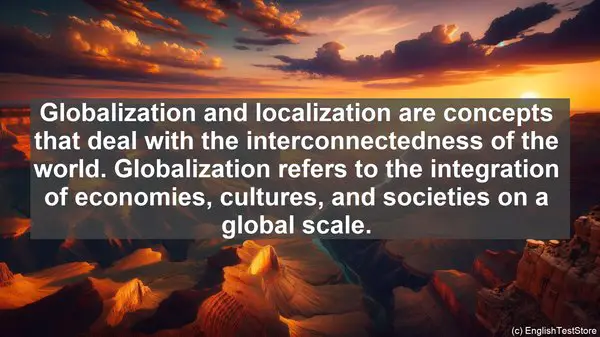Introduction
Welcome to today’s lesson. Human geography is a fascinating subject, but it can also be quite complex. One of the challenges students often face is the confusion between certain terms. In this lesson, we will address the top 10 commonly confused words in human geography, helping you to navigate through the subject with ease. So, let’s get started!
1. Urbanization vs. Suburbanization
Urbanization and suburbanization are two terms that are often used interchangeably, but they have distinct meanings. Urbanization refers to the process of an area becoming more urban, with an increase in population, infrastructure, and economic activities. On the other hand, suburbanization is the outward expansion of cities, leading to the development of suburbs. While both involve changes in the urban landscape, they represent different patterns and dynamics.
2. Globalization vs. Localization
Globalization and localization are concepts that deal with the interconnectedness of the world. Globalization refers to the integration of economies, cultures, and societies on a global scale. It emphasizes the interdependence and flow of ideas, goods, and people across borders. Localization, on the other hand, emphasizes the preservation of local cultures, traditions, and economies. It is about maintaining distinct identities in the face of globalization. Both are important, but they represent different approaches to the global-local dynamic.
3. Weather vs. Climate
Weather and climate are terms that are often used interchangeably, but they refer to different temporal scales. Weather is the day-to-day atmospheric conditions, including temperature, precipitation, and wind patterns. It is what we experience on a daily basis. Climate, on the other hand, is the long-term average of weather patterns in a particular region. It is the overall trend over a period of years or even centuries. Understanding the difference between weather and climate is crucial in studying the Earth’s climate system.
4. Migration vs. Immigration
Migration and immigration are terms that deal with the movement of people, but they have different perspectives. Migration is a broader term that encompasses any movement of people from one place to another, whether it is within a country or across international borders. Immigration, on the other hand, specifically refers to the movement of people into a country with the intention of settling there. It is a subset of migration. Both migration and immigration have significant social, economic, and political implications.

5. Formal vs. Functional Regions
Formal and functional regions are concepts used in geography to understand spatial patterns. A formal region is a defined area with a common characteristic, such as a political boundary or a climate zone. It has clear boundaries. A functional region, on the other hand, is defined by a particular function or activity that occurs within it. It is centered around a node or a focal point. Understanding the distinction between formal and functional regions helps in analyzing spatial relationships and patterns.

6. Demographics vs. Population Dynamics
Demographics and population dynamics are terms that deal with the study of populations, but they focus on different aspects. Demographics is the statistical study of population characteristics, such as age, gender, and income. It provides a snapshot of the population at a given time. Population dynamics, on the other hand, is concerned with the processes that shape and change populations over time, such as birth rates, death rates, and migration. It looks at the population from a dynamic perspective.
7. Topography vs. Bathymetry
Topography and bathymetry are terms that deal with the physical features of the Earth’s surface, but they have different applications. Topography refers to the elevation and relief of the land surface, including mountains, valleys, and plains. It is used to study terrestrial landscapes. Bathymetry, on the other hand, is the measurement of the depth and features of underwater areas, such as oceans and lakes. It is used in the study of marine and aquatic environments. Both provide valuable insights into the Earth’s surface.
8. Sovereignty vs. Autonomy
Sovereignty and autonomy are terms that deal with political power, but they represent different degrees of control. Sovereignty refers to the supreme authority and independence of a state. It is the highest level of political power, where a state has complete control over its internal and external affairs. Autonomy, on the other hand, refers to a lesser degree of control, where a region or community has some self-governing powers but is still part of a larger political entity. Both sovereignty and autonomy are important in understanding political systems.
9. Erosion vs. Weathering
Erosion and weathering are terms that deal with the breakdown and transportation of rocks and sediments, but they represent different processes. Weathering is the physical or chemical breakdown of rocks at or near the Earth’s surface. It is the initial step in the process. Erosion, on the other hand, is the transportation of the weathered material by wind, water, or ice. It is the movement of the broken-down material. Both weathering and erosion contribute to the shaping of the Earth’s surface.
10. Developed vs. Developing Countries
Developed and developing countries are terms that are used to categorize nations based on their level of economic and social development. Developed countries have high levels of industrialization, infrastructure, and living standards. They have advanced economies. Developing countries, on the other hand, are still in the process of industrialization and have lower living standards. They often face challenges in areas such as education, healthcare, and infrastructure. Understanding the differences between developed and developing countries is crucial in analyzing global inequalities and development strategies.
